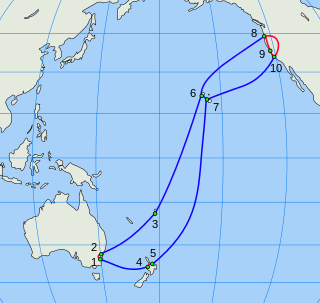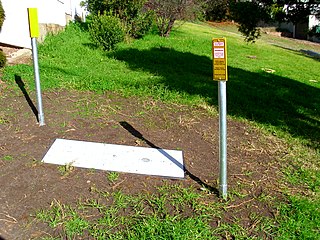Related Research Articles

Telecommunications in Australia refers to communication in Australia through electronic means, using devices such as telephone, television, radio or computer, and services such as the telephony and broadband networks. Telecommunications have always been important in Australia given the "tyranny of distance" with a dispersed population. Governments have driven telecommunication development and have a key role in its regulation.

The Southern Cross Cable is a trans-Pacific network of telecommunications cables commissioned in 2000. The network is operated by the Bermuda-registered company Southern Cross Cables Limited. The network has 28,900 km (18,000 mi) of submarine and 1,600 km (990 mi) of terrestrial fiber optic cables, all which operate in a triple-ring configuration. Initially, each cable had a bandwidth capacity of 120 gigabit/s. Southern Cross offers capacity services from 100M/STM-1 to 100 Gbit/s OTU-4, including 1G, 10G and 40G Ethernet Private Line services.
The Eastern Africa Submarine Cable System (EASSy) is an undersea fibre optic cable system connecting countries in Eastern Africa to the rest of the world.
SEA-ME-WE3 or South-East Asia - Middle East - Western Europe 3 is an optical submarine telecommunications cable linking those regions and is the longest in the world. Completed in late 2000, it is led by France Telecom and China Telecom, and is administered by Singtel, a telecommunications operator owned by the Government of Singapore. The Consortium is formed by 92 other investors from the telecom industry. It was commissioned in March 2000.

South East Asia–Middle East–Western Europe 4 is an optical fibre submarine communications cable system that carries telecommunications between Singapore, Malaysia, Thailand, Bangladesh, India, Sri Lanka, Pakistan, United Arab Emirates, Saudi Arabia, Egypt, Italy, Tunisia, Algeria and France. It is intended to be a complement to, rather than a replacement for, the SEA-ME-WE 3 cable.

The Australia–Japan Cable, or AJC, is a 12,700 km submarine telecommunications cable system linking Australia and Japan via Guam that became operational in 2001. It had an original design capacity of 640 Gbit/s, but was initially equipped to use only 80 Gbit/s of this capacity. In April 2008 a capacity upgrade was completed, bringing equipped capacity to 240 Gbit/s. Design capacity was also increased to 1000 Gbit/s. Further upgrades will increase equipped capacity to meet increasing demand.

A cable landing point is the location where a submarine or other underwater cable makes landfall. The term is most often used for the landfall points of submarine telecommunications cables and submarine power cables. The landing will either be direct or via a branch from a main cable using a submarine branching unit. The branch can be several kilometres long.

Alcatel–Lucent S.A. was a multinational telecommunications equipment company, headquartered in Boulogne-Billancourt, France. It was formed in 2006 by the merger of France-based Alcatel and U.S.-based Lucent, the latter being a successor of AT&T's Western Electric and a holding company of Bell Labs.
JASURAUS was a 5.332 Gbit/s, 2,800 km optical submarine telecommunications cable that connected Port Hedland, Australia, to Jakarta, Indonesia, with a further interconnection to the APCN and which was decommissioned in 2012.

Nextgen Networks is a wholly owned subsidiary of Vocus Group.
PacRimWest was a twin-pair 560 Mbit/s optical submarine telecommunications cable which served as Australia's main link to the world along with its partner cables Tasman2 and PacRimEast.
PIPE Pacific Cable (PPC-1) is a 6,900 km submarine cable laid by PIPE Networks. It runs from Cromer, New South Wales, in Australia, to Piti, Guam.

Greenland Connect is a submarine communications cable system that connects Canada, Greenland, and Iceland. The cable contains two fibre pairs specified for 128*10 Gbit/s wavelength each. Initial lit capacity is 1*10 Gbit/s for each fibre pair. Two additional 10 Gbit/s Wavelength were installed in the summer of 2010. The cable has cable landing points at:
Europe India Gateway (EIG) is a submarine communications cable system that connects the U.K., Portugal, Gibraltar, Monaco, France, Libya, Egypt, Saudi Arabia, Djibouti, Oman, United Arab Emirates, and India.

The West Africa Cable System (WACS) is a submarine communications cable linking South Africa with the United Kingdom along the west coast of Africa that was constructed by Alcatel-Lucent. The cable consists of four fibre pairs and is 14,530 km in length, linking from Yzerfontein in the Western Cape of South Africa to London in the United Kingdom. It has 14 landing points, 12 along the western coast of Africa and 2 in Europe completed on land by a cable termination station in London. The total cost for the cable system is $650 million. WACS was originally known as the Africa West Coast Cable (AWCC) and was planned to branch to South America but this was dropped and the system eventually became the West African Cable System.
Honotua is a submarine communications cable system that connects several islands of French Polynesia via Tahiti to Hawaii. The cable was laid by the cableship Île de Ré (câblier) between December 2009 and June 2010.
The Australia Singapore Cable (ASC) is a 4,600 km fibre-optic submarine communications cable that entered service in September 2018, linking Australia and Singapore via Christmas Island and Indonesia. ASC is owned and operated by Vocus Communications and interconnects with the Vocus Australian domestic optical fibre network at the Australian landing site in Perth. The ASC consists of four fibre pairs and, at launch, had a total design capacity of 40 terabits per second.
Tasman Global Access (TGA) is a 2,288 km fibre-optic submarine communications cable that entered service in 2017, linking Australia and New Zealand. TGA consists of two fibre pairs and has a total design capacity of 20 terabits per second.
The Oman Australia Cable (OAC) is a 9,800 km fibre-optic submarine communications cable that entered service in September 2022, linking Oman and Australia via the Cocos (Keeling) Islands. The cable consists of three fibre pairs and had an initial design capacity of 39 terabits per second.
References
- ↑ "Telstra doubling lit capacity on Endeavour Hawaii cable | CommsDay". Archived from the original on 31 December 2009. Retrieved 16 April 2010. Telstra doubling lit capacity on Endeavour Hawaii cable
- ↑ Telstra Media Release, "Telstra continues aggressive investment with Australia to USA connection", 28 March 2007
- ↑ Rossi, Sandra, "Telstra unveils largest submarine cable connection to US – 9000km from Sydney to Hawaii", Computerworld , 29 March 2007
- ↑ "Telstra hits 100G on key Asia-Pac submarine cables" . Retrieved 21 July 2023.
- ↑ "Next Generation Cable Systems, Telstra Endeavour, Sydney, Australia to Hawaii, USA" (PDF). Retrieved 9 July 2009.
- ↑ Alcatel-Lucent media release Telstra awards Alcatel-Lucent 9,000 km submarine network contract to support IP network transformation strategy, Paris, 28 March 2007